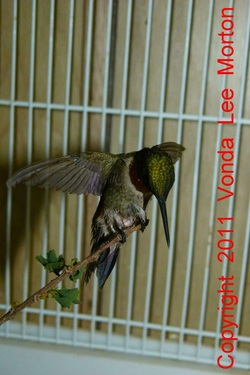
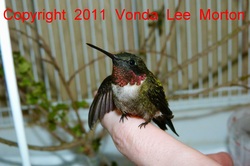
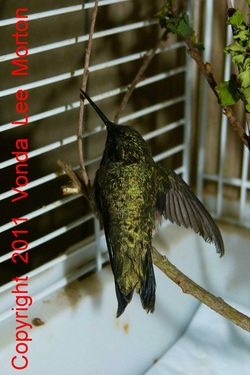

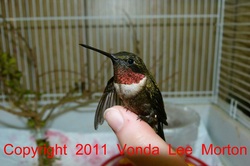
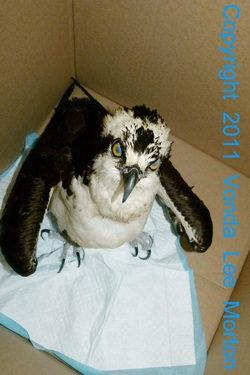

 Go ahead, groan, but how could I resist that name for a ruby-throated hummingbird?! Since his name is bigger than he is, we’ll just call him Dinky for short. Dinky came in with a probable broken right wing; x-rays were inconclusive since we had to set the exposure very low so as not to administer a lethal dose of radiation to the “leetle feller.”  He’d been taken away from a cat (cue standard “indoor-only cats can’t kill birds” rant here…you’ve read it enough in previous posts) several days before I received him; the finder couldn’t get anyone to answer her calls until she got hold of Steve Hicks of Bubba and Friends raptor rehab (www.bubba-and-friends.org). Steve rehabs raptors exclusively, but since he was headed my way the next day to pick up the osprey from the last update, he agreed to take the bird and bring him to me when he came.  Since hummers need to eat every 20 minutes because of their high metabolisms, I was delighted that Dinky was self-feeding. He has been happily slurping a special nectar designed for use in rehab settings, which contains all the nutrients hummers need that normal hummer nectar doesn’t contain. In other words, don’t try this at home, boys and girls! In addition to the fact that it’s illegal without the proper state and federal permits, there’s also the fact that hummers are high-maintenance birds and difficult to rehab.  He may be unreleasable because of that right wing; we’ll have to wait and see. He can flutter it quite well but can get no lift. In the meantime, Dinky is a nosy rascal who often appears to be challenging me: he cocks his little head and flashes his red throat while jealously guarding his “stash” of rehab nectar. Yeah, like I want to drink it; it doesn’t smell all that appetizing to this non-hummer!  Birds in general are amazing, but hummers are especially so. I mean, stop and realize that something so tiny—weighing only a tenth of an ounce, two tenths at the outside—that must eat every 20 minutes to survive, crosses the Gulf of Mexico or hugs the Texas coast each fall, a 500-mile trip that takes nearly 24 hours to complete, to reach their wintering territory. Most hummers don’t survive their first year; those that do have an average life expectancy of 3-4 years. They’re pretty awesome little birds!  LWR also had another osprey come in this past week, this one with matching wing injuries. He had infected, draining spots on both wings below the wrists. We have no clue how he was originally injured; our initial guess was gunshot, but when vet Shelley Baumann of Smalley’s Animal Hospital x-rayed him, there was no lead and there were no broken bones, so it’s anybody’s guess. He’s on antibiotics and will be headed to Bubba and Friends soon.  And just today, we received seven young possums, about three months old. (Trust me, there are 7 in there; they’re in a big pile!) Their mother had been hit by a car, but the finders kept the babies for a week, feeding them only once a day, before getting them to LWR this afternoon. They’re severely malnourished as a result, and the jury’s still out on their fate. I’m hoping they respond well to regular feedings of a proper diet, but we’ll have to see. The squirrels are moving into release phase and have gotten very camera-shy, so no photos of them this week. I’ll see if I can sneak a few for the next update, but they’re pretty sharp bushy-tails and scurry for cover when they see the camera!
1 Comment
Judy Warmack
5/12/2011 07:26:36 pm
Enjoyed reading about the animals that you have rescued. Always sad to read about those that didn't make it. I'm very interested to know if you will continue to keep the little hummingbird if he is unable to be released or place him in a different facility? I have not been successful in finding a facility willing to take non-releasable high maintenance hummers in Southern Georgia.
Reply
Your comment will be posted after it is approved.
Leave a Reply. |
Archives
April 2023
Categories
All
|